Nestled within the charming embrace of Prague’s Old Town Square, the Astronomical Clock emerges as an exquisite masterpiece that has captured the hearts and imaginations of generations, leaving an indelible mark on those fortunate enough to behold its beauty. This iconic timekeeping marvel, adorned with intricate architecture and adorned with beguiling, animated figures, weaves a mesmerizing narrative that transcends the mere measurement of time.
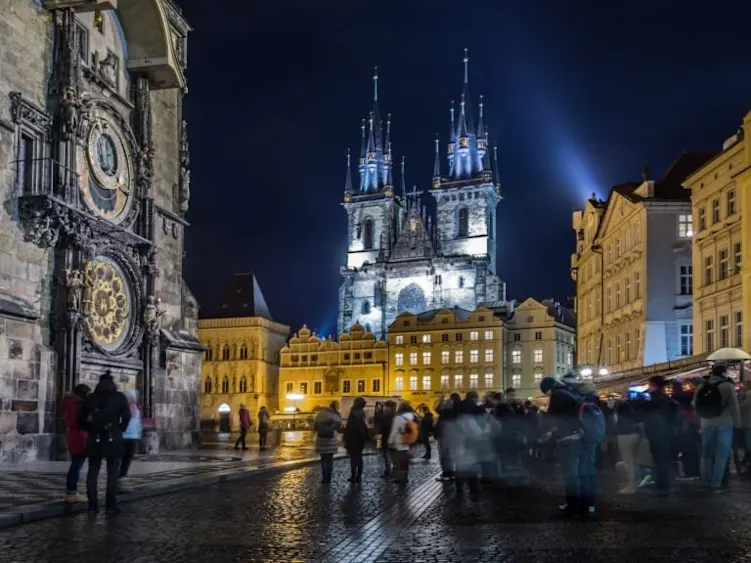
Nestled within the charming embrace of Prague’s Old Town Square, the Astronomical Clock emerges as an exquisite masterpiece that has captured the hearts and imaginations of generations, leaving an indelible mark on those fortunate enough to behold its beauty. This iconic timekeeping marvel, adorned with intricate architecture and adorned with beguiling, animated figures, weaves a mesmerizing narrative that transcends the mere measurement of time.
The Astronomical Clock is a living testament to Prague’s historical tapestry, serving as a bridge between eras and a custodian of the city’s rich heritage. Its presence evokes a sense of awe and reverence, inviting both locals and globe-trotting explorers to pause and contemplate the passage of time in a world characterized by rapid change.
Beyond its functional purpose, the Astronomical Clock is a symphony of artistry, craftsmanship, and engineering ingenuity. Its animated figures, brought to life with each passing hour, beckon observers into a whimsical realm where time converges with artistic expression. This exquisite dance of celestial bodies and mechanical prowess transforms the clock into a captivating visual spectacle, an immersive experience that leaves an indelible imprint on the minds of those fortunate enough to witness it.
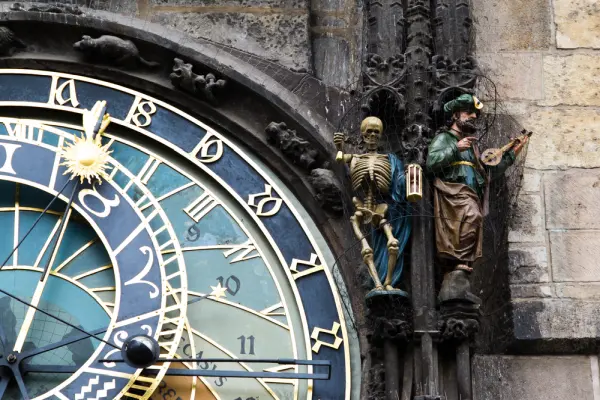
As the sun casts its golden glow upon Prague’s cobblestone streets, the Astronomical Clock stands as a beacon of continuity, an enduring reminder of the city’s storied past and limitless potential. Its presence symbolizes more than the passage of hours; it is a testament to the human spirit’s unrelenting quest for beauty, understanding, and connection across the expanse of time.
The Astronomical Clock, also known as the Prague Orloj, is a fascinating fusion of art and engineering. Its origins can be traced back to the 15th century when it was constructed by the master clockmaker Mikuláš of Kadaň in collaboration with Jan Šindel, a renowned professor of mathematics and astronomy. The clock’s mesmerizing architecture showcases a blend of Gothic and Renaissance styles, reflecting the cultural influences of the time.
The year 2010 marked a momentous occasion as the Astronomical Clock in Prague proudly celebrated its remarkable 600th anniversary. This significant milestone stands as a testament to the clock’s enduring legacy and profound historical significance. Over the centuries, the clock has not only weathered the relentless passage of time but has thrived as an enduring symbol of Prague’s rich cultural heritage and technological prowess.
As the centuries rolled by, the Astronomical Clock emerged as a vibrant and functional timekeeping marvel, defying the odds and capturing the fascination of generations. Its intricate gears and mechanisms have faithfully kept time, offering a tangible link to the past while gracefully transitioning into the present. This resilient timepiece continues to grace Prague’s Old Town Square with its captivating presence, beckoning both locals and global travellers to witness the harmonious dance of art and science that defines its essence.
The 600th anniversary celebration served as a poignant reminder of the clock’s unwavering resilience and timeless allure. This milestone not only commemorated the clock’s illustrious history but also highlighted its relevance in the contemporary world. As visitors gather in awe to witness the clock’s animated figures and intricate movements, they become part of a grand narrative that spans six centuries, a narrative that encapsulates the spirit of innovation, cultural pride, and the timeless quest for understanding the mysteries of the universe. Perched atop the Old Town Hall Tower, the Astronomical Clock is a central feature of this historic landmark. The tower itself boasts remarkable medieval architecture and offers panoramic views of the charming Old Town Square and beyond.
The Astronomical Clock is a multi-faceted marvel. It serves as both a clock and a complex astronomical instrument, displaying various measurements of time, including the position of the sun and the phases of the moon. The clock also features a calendar dial that includes zodiac symbols, and the intricate movement of its gears orchestrates a captivating display of animated figures.
Every hour, visitors are treated to a captivating spectacle as the clock’s animated figures come to life. The Twelve Apostles, accompanied by the figure of Death, parade before an adoring crowd. The Walk of the Apostles is a symphony of motion and symbolism, a testament to the clock’s ingenious design.
The Astronomical Clock has a storied past, surviving fires, wars, and the passage of time. Legends shroud its creation, including a tragic tale of blinding the clockmaker to prevent him from replicating his masterpiece. These stories add a touch of mystique to an already enchanting landmark.
Throughout its history, the Astronomical Clock has remained a timeless attraction, drawing visitors from around the world to witness its beauty and brilliance. Its enduring allure lies not only in its functionality but also in its ability to transport us to a bygone era, where art, science, and craftsmanship converged.
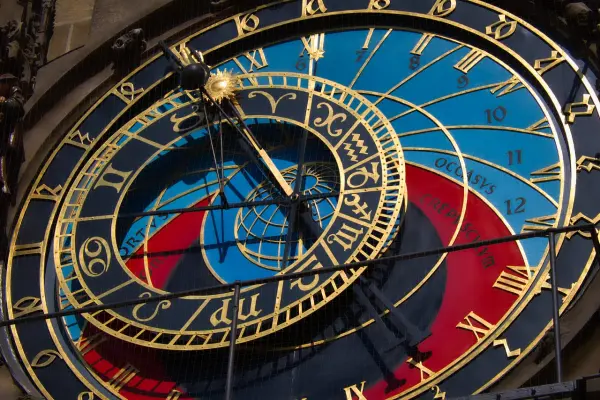
The History of the Prague Astronomical Clock
The Prague Astronomical Clock’s roots trace back to the beginning of the 15th century. Constructed in 1410 by the clockmaker Mikuláš of Kadaň and Jan Šindel, a professor of mathematics and astronomy at Charles University in Prague, the clock was initially designed as an astronomical dial to depict the movement of celestial bodies.
Key Milestones of the Prague Astronomical Clock´s history
- 1490: The calendar dial, located below the main astronomical face, was added by Master Hanuš (Jan Růže). Legends claim that the city councillors blinded Hanuš to prevent him from replicating the masterpiece elsewhere, though historical evidence for this tale is scant.
- 1552-1572: During this period, major enhancements, including adding the clock’s third and fourth dials, were implemented.
- 1787-1865: Unfortunately, the clock faced periods of neglect and disrepair during the late 18th and early 19th centuries. It underwent significant repairs in 1865-1866 by the master clockmaker Ludvík Hainz.
- 1945: Towards the end of World War II, the Prague Astronomical Clock was severely damaged during the Prague Uprising. This event marked a major blow to the historic structure, causing it to cease functioning.
- 1948: A significant restoration effort took place post-war, bringing the clock back to its full operational and aesthetic glory.
- 2018: In recent times, the clock was temporarily disassembled for a significant restoration project, and it was unveiled once more in all its grandeur later that year.
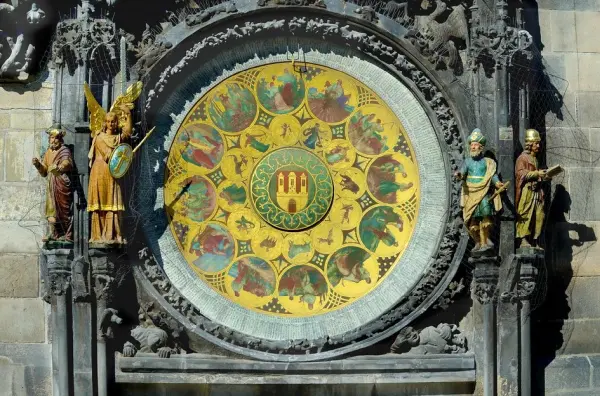
Why is Prague Astronomical Clock famous?
The Prague Astronomical Clock, or “Pražský orloj”, is renowned for several reasons, spanning from its historical significance to its intricate design and mechanics:
- Age and Authenticity: Installed in 1410, the Pražský orloj is the third oldest astronomical clock in the world and the oldest one still in operation. Its longevity and historical relevance have made it an enduring symbol of Prague’s rich past.
- Complex Mechanics: The clock is a marvel of medieval engineering. It doesn’t just tell the time; it displays astronomical information, such as the position of the sun and moon, lunar phases, and the zodiacal ring. The clock’s ability to provide both astronomical and standard time showcases the technical prowess of its creators.
- Artistic Masterpiece: The visual appeal of the clock is undeniable. From the beautifully adorned calendar dial with zodiacal symbols to the hourly “Walk of the Apostles” – a procession of figures representing the 12 apostles – the clock is an intricate fusion of craftsmanship, artistry, and functionality.
- Cultural and Historical Significance: Beyond its aesthetic and technical merits, the clock has borne witness to significant historical events in Prague over the last six centuries. It has endured wars, invasions, and urban transformations, making it a living relic of the city’s tumultuous history.
- Legends: Myths and legends have always surrounded the clock. One popular legend claims that the city councillors blinded the clock’s creator, Master Hanuš, to prevent him from reproducing a similar masterpiece elsewhere. This has added an air of mystique to the clock, further enhancing its allure.
- Tourist Attraction: The hourly show, where statues of the Apostles and other figures animate, draws large crowds. This performance, paired with the clock’s storied history, has made it a must-visit for anyone traveling to Prague.
- Symbol of Prague: Over time, the Pražský orloj has evolved into an emblematic landmark of Prague. Its representation is often used in various media, souvenirs, and promotional materials related to the city.
In essence, the fame of the Prague Astronomical Clock is a combination of its technical sophistication, artistic beauty, historical importance, and cultural significance, making it a beloved treasure not just for the Czech people but for admirers worldwide.
Best of Prague Astronomical Clock
Here are some of the best parts of the Prague Astronomical Clock:
- The astronomical dial: This is the oldest part of the clock and it shows the time, the position of the sun and moon in the sky, and the moon’s phases. The dial is divided into 12 hours, each represented by a different symbol.
- The calendar dial was added later and shows the day of the month, the month, and the zodiac signs. The dial is decorated with beautiful astrological symbols.
- The moving figures: These figures are the most famous part of the clock and they come alive every hour. The figures represent the twelve apostles, the skeleton of Death, and a Turk.
When the clock strikes the hour, the apostles emerge from the clock tower and march around the dial. Death rings a bell and the Turk shakes his head.
The Prague Astronomical Clock is a fascinating and beautiful clock that is a must-see for any visitor to Prague.
Prague Astronomical Clock: a timepiece, a work of art and a cultural symbol
The Astronomical Clock in Prague stands as a living embodiment of the intricate interplay between humanity’s creative spirit and the relentless march of time. It transcends its utilitarian purpose, transcending the mere measurement of hours and minutes. Instead, it is a symphony composed of ingenuity, artistry, and cultural legacy that resonates across centuries.
As visitors gather in the bustling embrace of Prague’s Old Town Square, they are not merely spectators; they become participants in a grand theatrical production that unfolds with every passing hour. The Walk of the Apostles is more than a mechanical marvel; it is a gateway to a realm where the past, present, and future intertwine. In this fleeting moment, history’s footsteps echo, present aspirations flourish, and future dreams take flight. It’s a temporal junction where the legacy of yesteryears meets the aspirations of tomorrow.
The Astronomical Clock’s resonance goes beyond the mechanical ticking of gears. It is a storyteller, relaying the narratives of countless generations, artists, scientists, and visionaries who contributed to its existence. Its enchanting facade, adorned with intricate carvings and celestial symbols, offers a glimpse into the aesthetics of a bygone era. The legends that encircle it, like whispered secrets from time’s depths, invite curious minds to ponder the mystical and the mundane.
In this dance of history, the clock’s legacy endures as an invitation to delve deeper into its mysteries. It beckons explorers to peel back the layers of its intricate mechanisms and uncover the secrets hidden within. With every visit, a sense of connection to the artisans of the past is kindled, forging a bridge between distant eras.
The Astronomical Clock is a vessel that carries within it the essence of Prague’s identity, a time capsule that encapsulates the city’s resilience, creativity, and cultural heritage. It thrives not only as a historical relic but as a dynamic force, igniting the imagination and kindling the flames of curiosity. With each tick and tock, it reaffirms its role as a timeless guardian, keeping watch over the city’s pulse, and preserving the spirit of those who came before.
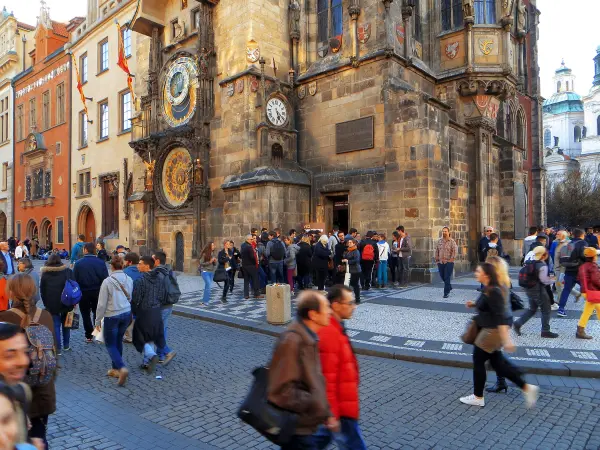
The Astronomical Clock – FAQ
Where is the Astronomical Clock located?
The Astronomical Clock, a mesmerizing timekeeping marvel, finds its home atop the illustrious Old Town Hall Tower in the heart of Prague’s enchanting Old Town Square.
How old is the Astronomical Clock?
The Astronomical Clock’s origins trace back to the 15th century, specifically the year 1410, unveiling a journey of over six centuries.
Who built the Astronomical Clock in Prague?
The Astronomical Clock stands as a testament to the collaborative genius of two visionaries. Master clockmaker Mikuláš of Kadaň, driven by a passion for precision, joined forces with Jan Šindel, a distinguished professor of mathematics and astronomy. Their combined expertise birthed a masterpiece that continues to capture imaginations to this day.
What does the Astronomical Clock show?
The Astronomical Clock is not a mere timekeeping device; it is a symphony of celestial measurements. Its complex mechanisms choreograph a dance of the sun’s position, lunar phases, and the passage of time itself. The calendar dial adorned with zodiac symbols adds a touch of cosmic allure to this captivating display.
How does the Walk of the Apostles work?
At the top of every hour, a symphony of movement unfolds as animated figures, representing the Twelve Apostles and the elusive figure of Death, emerge from the clock. This intricate and enchanting spectacle, known as the Walk of the Apostles, is a harmonious celebration of mechanical artistry and symbolic storytelling.
What is the legend behind the Astronomical Clock?
The Astronomical Clock is steeped in legend, one of which whispers of the clockmaker’s fate. It is said that to safeguard the clock’s uniqueness, its creator was blinded, ensuring that his genius could never be replicated. This mythical tale adds an air of mystery to the clock’s already captivating narrative.
Is there an entrance fee to see the Astronomical Clock?
In a gesture of cultural generosity, there is no entrance fee to bask in the Astronomical Clock’s splendor. This grand timekeeping spectacle remains accessible to all, inviting individuals from all walks of life to partake in its majesty.
What is the best time to visit the Astronomical Clock?
The best time to visit the Prague Astronomical Clock is early in the morning or late in the evening when the crowds are smaller. The clock is most crowded during the day, especially around the hour when the moving figures come alive.
Specific visit times to consider
- Early morning: The clock is open from 9:00 AM to 11:00 PM, but the best time to see the moving figures is at the hour. If you want to avoid the crowds, try to visit the clock early, before 10:00 AM.
- Late evening: The clock is also less crowded in the late evening, after 8:00 PM. However, the moving figures only come alive during the day, so you won’t be able to see them at this time.
If you are visiting Prague during the peak tourist season, it may be difficult to avoid crowds at any time of day. In this case, you may want to try to visit the clock on a weekday, when there are fewer tourists.
No matter what time you visit, arrive early to get a good spot and avoid crowds. The Prague Astronomical Clock is a popular tourist attraction and it can get very crowded, especially around the hour when the moving figures come alive.





